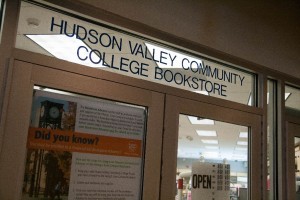Punched in the textiscles: The high cost of textbooks and where the money goes

David Ellis, Staff Writer
Buying textbooks on campus generates money that helps the school’s economy, but is it worth spending more than you would by renting or buying elsewhere?
The Viking’s Cove Bookstore is part of the Faculty Student Association (FSA). The FSA provides auxiliary services to the college and is comprised of the FSA Business Office, bookstore, daycare center and food services and is a separate entity from the college.
“It’s not like the bookstore’s a stand-alone organization by itself. It’s not governed by an outside company, it’s [governed by] the FSA, within the college itself,” said Stephan Stegman, bookstore manager.
“The money that students spend here on campus, in the bookstore, stays here on campus. Profits that are generated via the bookstore or via the FSA are poured back into the college to support different services and different things among the college,” said Stegman.
Students are also able to take advantage of customized services, such as the pre-pack.
“To do the pre-pack service, students don’t need to know what books they need,” said Stegman.
Students can bring their class schedules into the bookstore or use the bookstore’s website to fill out a pre-pack form and not worry about what materials they will need for their classes.
Financial aid can also be used at the bookstore for purchasing several materials. Students who qualify for financial aid may be eligible for a bookstore waiver or bookstore advance for up to $600 for both the fall and spring semesters.
“Students can basically buy textbooks, supplies, electronics, computer equipment and software,” said Stegman.
In the last fiscal year, the FSA contributed over $102,000 back to the college. In previous years, the FSA paid for the construction of the Daycare Center, which cost over $3 million, the parking across the street from the campus and close to $1 million for renovations to the campus center.
The bookstore also buys back textbooks, putting over $287,000 in the hands of students last year.
“All of these things add up and if we didn’t do these things, I don’t know how they would be paid for, or if the college could do them at all. One of the ways might be higher tuition for students,” said Stegman.
While the FSA contributes to campus development, many students have expressed concern over the bookstore’s pricing.
“The bookstore prices are pricey. If you buy books on the internet, they are cheaper. In the sense of buying them at school, it’s like scoring brownie points; I can get school supplies cheaper at Wal-Mart,” said Cassandra Horton, freshmen animal advocacy major.
In the past three decades, college textbook prices have increased faster than tuition, healthcare costs, housing prices and inflation. The National Association of College Stores says the average college student will spend over $655 on textbooks each year. However, according to College Board, the average student spends about $1,200 on books and supplies.
“I did not purchase my required textbooks from the bookstore because they are very expensive and I can get them elsewhere for cheaper. I am currently renting my books from Amazon,” said Danielle Gabel, senior individual studies major.
“Last year, I cashed in my books at the end of the semester but I didn’t make a lot of money off of them. The bookstore doesn’t always take every book back. I know they charge high prices so the school can make money, but I wouldn’t purchase texts from them because I like to manage my finances,” said Gabel.
According to a recent article from the U.S. News and World Report, roughly one-fifth of a textbook’s price goes to the store where it is sold to cover personnel and operating costs, while more than three-quarters goes straight to the publisher.
The sticker price on books is often higher when supplemental materials such as CDs and online content are included with the purchase of a text.
A recent report by USA Today found that in the past decade alone, the cost of textbooks has risen 82 percent.
